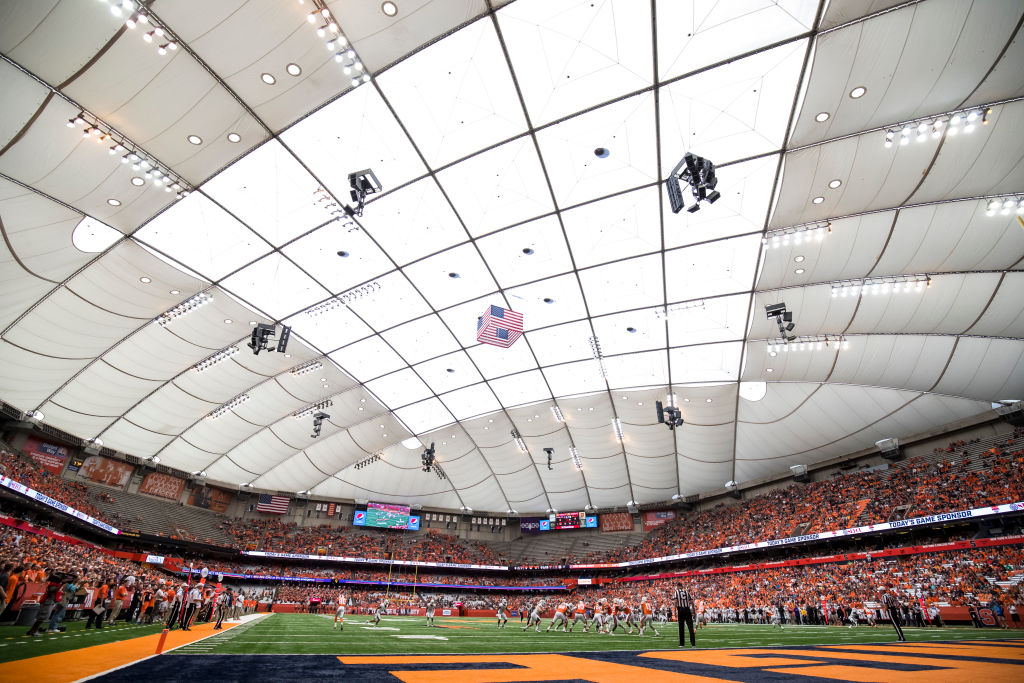NCAA
The Carrier Dome's Roof Has Been Deflated One Last Time

Basketball teams that run down the clock before shooting while preserving a late lead are said to be taking the air out of the ball. Syracuse University has gone one better by taking the air out of the roof above the ball.
Construction crews working at the Carrier Dome deflated the building’s roof for the final time Monday as renovations continued on the facility that became synonymous with the rise of Big East basketball in the 1980s.
The Carrier Dome’s roof comes down to make way for a new one
The roof of the Carrier Dome on the Syracuse University campus was deflated in an hour-long process and will be disassembled this week, with some pieces given to this spring’s graduates as a memento. Other pieces are expected to be sold as a fundraiser.
The deflated roof sank to within approximately 30 feet of the stadium floor as workers began cutting it down. The roof had been held in place on the Syracuse skyline for four decades by a forced-air design that kept it inflated above the building’s more than 45,000 seats and a playing surface that hosted Syracuse football, basketball, and lacrosse games.
The Carrier Dome was the last major U.S. stadium using the forced-air design, outlasting the RCA Dome in Indianapolis, the Metrodome in Minneapolis, and the Silverdome in Pontiac, Michigan. Syracuse is replacing it with a tension-membrane design as a major renovation of the building that will continue into 2022.
The next scheduled contest in the Carrier Dome is a football game against Colgate on Sept. 19.
The Carrier Dome, The Big East, and ESPN rose together
Syracuse University began playing in the Atlantic Coast Conference in the fall of 2013 after withdrawing from the Big East, which it helped form in 1979 to give major basketball programs in the northeast a home.
Existing rivalries grew even bigger, fueled by ESPN and furious recruiting that brought stars like Patrick Ewing (Georgetown), Chris Mullin (St. John’s), and Derrick Coleman and Pearl Washington (Syracuse) into the league. Syracuse home showdowns against the Hoyas, Redmen, UConn, and Villanova drew crowds of 30,000 or more fans.
The Big East hit its competitive peak in 1985 when Villanova defeated Georgetown in the NCAA Tournament final with St. John’s also playing in the Final Four.
More recently, Duke And North Carolina have been major drawing cards for Syracuse home games. Syracuse led the NCAA in men’s basketball attendance every season from 1985 to 1995 and three more times between 2005 and 2014.
A curious note about the Carrier Dome’s name
The Carrier Dome was completed in September 1980 at a cost of $26.85 million in school and state funding. Part of the expense was defrayed by $2.75 million that the Carrier Corp. paid for naming right to the building. Despite cooling equipment
The university stopped referring to the building as the Carrier Dome last fall.
Because the two generations of Teflon-coated fiberglass forming the 220-ton roof were supported by air, the building operators would sometimes raise the temperature to keep snow from accumulating on the roof and potentially collapsing it. The roof was intentionally collapsed in March 1993 as a safety measure as nearly four feet of snow fell in the region.











